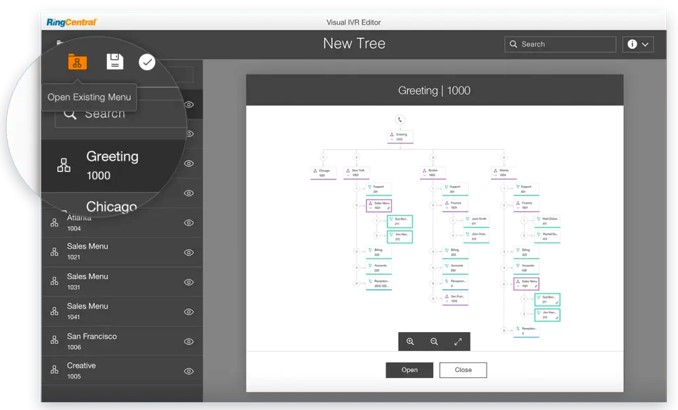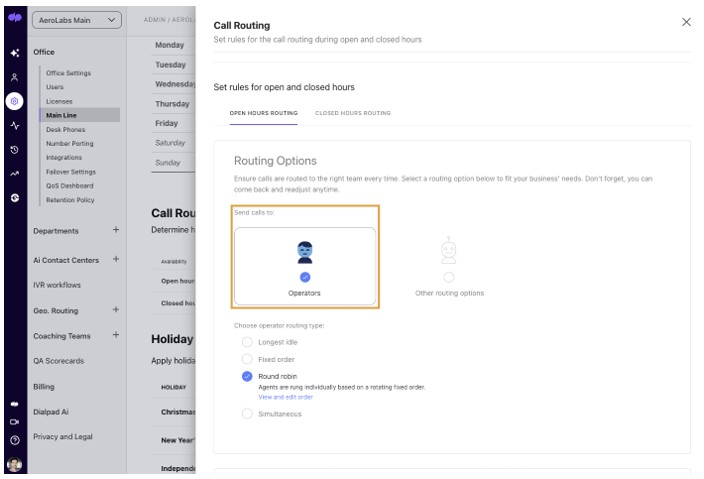Call routing is a call management feature that directs inbound calls to the right service representatives based on preconfigured rules. It boosts team productivity, spreading the workload among agents. This feature reduces operational costs, as businesses don’t need to rely on receptionists manually distributing incoming calls. Although call routing offers many benefits, companies must follow best practices, such as identifying trends in customer inquiries, to maximize this tool.
How Call Routing Works
As part of call management systems, call distribution works by using the information provided by the caller. It occurs in several ways, depending on the rules you set in your interactive voice response (IVR) system.
- Qualifying phase: When a customer makes a call, an IVR will process their responses to identify the caller’s purpose and the type of assistance they need. The caller will use their voice or dial pad to respond to the series of prerecorded questions or call menu options.
- Call queuing phase: The IVR forwards the collected data to the automatic call distributor (ACD) for queuing. The ACD will queue incoming calls based on specific criteria, such as the type of query, waiting time, or agent skills.
- Call distribution phase: The calls will stay in queues until an agent is ready to take their call. The queuing process depends on the rules you’ve set for the call distribution method. For example, skills-based routing is used to route calls to the most qualified agent. This process ensures that a call is handled by the right individual or department.
Types of Call Routing Strategies
One of the best ways to understand better what is call routing is to be familiar with the various ways inbound calls are distributed in the phone system. Voice-over-internet-protocol (VoIP) phone systems offer different configurations for routing calls, such as round-robin, skills-based, and geographic methods. Refer to the table below for the different types of call distribution:
Call Routing Method | How It Works | How It Benefits Businesses |
|---|---|---|
Automated Routing | Automatically answers and sends phone calls to different agents based on predefined criteria | Improves business image, as it picks up calls automatically and prevents busy signals |
Fixed Order | Directs calls to the first agent and then to the next available one | Reduces wait times as the calls are immediately picked up by a dedicated agent and the next available representative when the first one is busy |
Time-based Routing | Sends calls to different agents, departments, or contact centers in other locations based on business hours or a specific time of the day | Facilitates 24/7 customer support and offers the opportunity to establish international presence |
Skills-based Routing | Distributes calls to agents who are most qualified to answer specific customer concerns | Speeds up call resolution, as representatives with expertise handle the inquiries |
Round-robin Routing | Assigns calls evenly to agents | Guarantees that agents get a fair share of calls and the workload is split properly |
Predictive Behavioral Routing | Uses artificial intelligence (AI) to find the agent that can handle the caller’s personality, communication styles, and emotional state | Increases call resolution and helps build rapport with customers |
Campaign-based Routing | Directs callers to agents handling the specific sales or marketing campaign customers are calling for | Ensures that callers are able to speak to company representatives with knowledge about the offer being inquired about |
Geographic Routing | Sends calls to different offices based on the caller’s area code | Offers better customer service to local audiences |
Percentage-based Routing | Divides the number of calls among teams or different call centers, sending a certain percentage to a particular group (for example, one group gets 70% of the calls, another receives 20%, and another is assigned 10%) | Distributes phone calls to multiple call centers, allowing businesses to manage high-volume calls |
Talk-time Routing | Forwards calls to the agent with the least talk-time with customers | Minimizes idle time for agents |
VIP Routing | Assigns important clients to dedicated service representatives | Provides top-notch service for VIPs, as the agents are already familiar with what the clients need and want |
Top Providers That Offer Call Routing
Cloud-based business phone systems offer a range of call distribution methods as part of their VoIP features. The variety enables businesses to be flexible in managing inbound calls. If you’re looking for a new software solution, consider our top-recommended VoIP platforms:
Benefits of a Good Call Routing System
When configured strategically, call routing for small businesses enhances customer service, agent productivity, and overall operations. These are the specific ways it contributes to these mentioned benefits:
Using automated call routing minimizes wait times, as the process of distributing phone calls happens instantly, as opposed to having a receptionist transfer calls to appropriate departments manually. This is especially beneficial when you frequently get large volumes of calls. With customers spending less waiting time, they are less likely to abandon calls.
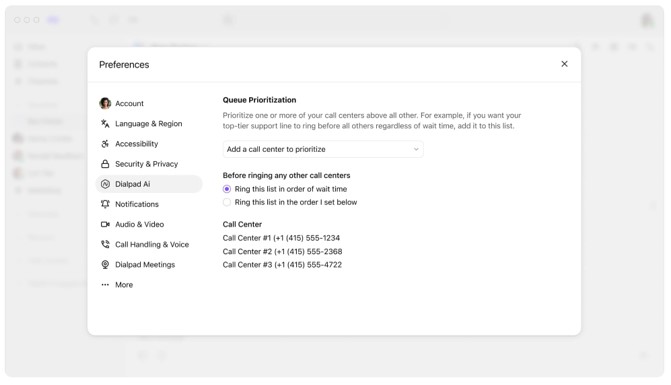
Dialpad offers the option to prioritize callers who have been waiting the longest in the queue. (Source: Dialpad)
Addressing inquiries more quickly is possible not only because of the reduced waiting times but also because of the assignment of calls to the right representatives. For instance, when you use skills-based routing, those with technical concerns will get meaningful advice from customer support. When the system is configured for geographic routing, customers are more likely to speak to an agent trained to handle local concerns and speak the local language.
As mentioned above, the round-robin call distribution method allows you to designate calls evenly among service representatives. This ensures that no one underperforms or is overburdened by the calls your business receives. On top of this, phone call routing systems take into account agents’ current status and schedules when assigning calls. This prevents employees from being overworked.
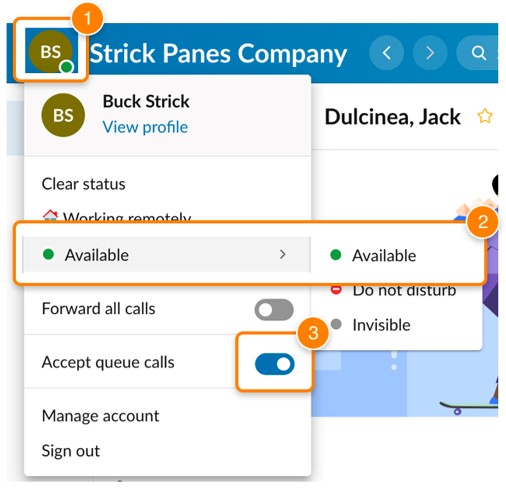
RingCentral offers agents the flexibility to turn on and off receiving calls in a queue. (Source: RingCentral)
Calls being assigned to the most qualified agents helps not only the customers but also the service representatives themselves. As they resolve concerns faster, they are able to accommodate more and become deeply familiar with the common inquiries assigned to them. Over time, this sharpens their knowledge of products and services, and, in turn, makes them more efficient in handling concerns.
With advanced call routing systems organizing and sending phone calls efficiently, you don’t need to hire more agents to traffic inquiries. When you use this feature with call analytics, which displays key performance metrics, you’ll learn strategies for optimizing call distribution further. Ultimately, you boost efficiency and lower operational costs.
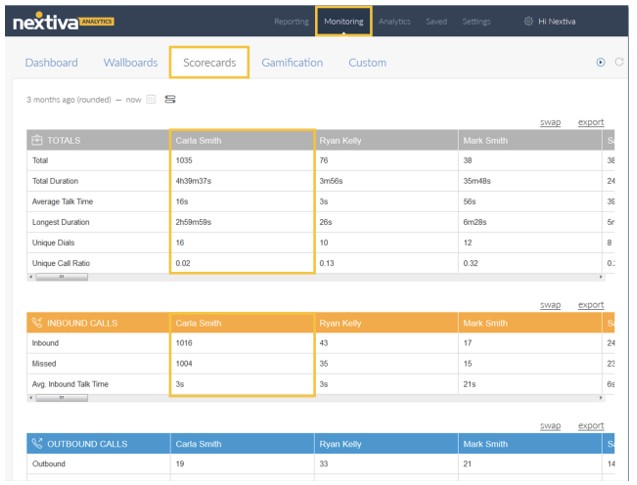
Nextiva’s analytics tool shows individual agent performance scorecards. (Source: Nextiva)
Call Routing Best Practices to Follow
Although small business call routing systems offer several benefits, companies will only maximize them when they adopt effective communication practices. Make sure to observe these habits as you select the right type of call distribution methods in your phone system:
Revisit past interactions with callers and learn common concerns to build a call flow that properly accommodates client needs. Pay close attention to negative sentiments, as these are potential areas for improvement. If possible, solicit feedback from customers directly through a post-call survey.
With the poll insights, you’ll know how long they waited in the queue or if they were able to get the answers they needed within a specific period. From there, adjust call distribution strategies.
Part of IVR design best practices is using professional, natural-sounding announcements to make them easily understandable. As much as possible, limit the menu options to less than four. The submenus shouldn’t be more than three. Otherwise, the caller may be frustrated over the long period of interacting with menus and not being able to speak to an agent. Always include in your menu the option to be transferred to a live representative.
By informing callers how long they’ll be in the queue, agents are able to manage their expectations while waiting. As they stay on the line, make the waiting time bearable by playing soothing music and useful reminders from your company. On the flip side, offer the callback option so clients can choose not to wait in line, go about their business, and still get assistance from your company.
Observe live calls by using call whisper. After each session, provide feedback to agents for improving customer communications. At the same time, refer to important metrics, such as average handle time (AHT), call abandonment rate, average time in queue, and first call resolution. Use these performance indicators to recalibrate training and coaching programs for service representatives.
When connected to a CRM platform, business phone systems automatically display customer profiles during a live call, allowing agents to see personal contact details, account and transaction history, and previous call notes. This allows them to understand better the context of concerns, offer helpful advice to clients, and speed up resolving inquiries.
Call Routing Mistakes to Avoid
As much as it’s important to observe best practices for call distribution, you must also be wary of common mistakes businesses make when managing calls. The blunders outlined below can negatively affect customer experience and company image:
This experience is incredibly frustrating to customers, not only because it wastes precious time, but also because they typically have to share the same information over and over. As much as possible, limit the transfers between departments or agents by equipping service representatives to handle a variety of concerns.
There are instances when customers choose the wrong menu option from the IVR, so directing them to another representative is inevitable. But make sure agents get all the relevant information from the customer to determine the appropriate department to send the call to. If you’re using live answering services, your outsourced agents must know where to direct specific inquiries to reduce the number of transfers.
When you launch a sales campaign or announce major news like a product recall or pricing change, expect to receive more phone calls than usual. Maximize trend forecasting and predictive analytics tools in your business phone system to ensure you have enough agents handling the huge volume of calls. Consider adding phone numbers or extensions to manage long queues.
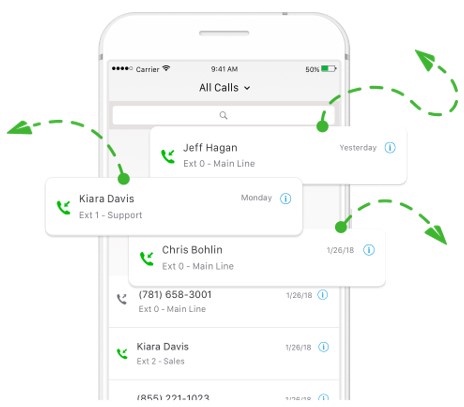
Grasshopper’s virtual extensions allow you to assign numbers to different departments. (Source: Grasshopper)
Virtual phone system Grasshopper offers multiple extensions in all its subscription plans, with the most expensive package providing unlimited extensions. Secure multiple phone numbers when you upgrade plans or pay an extra $10 monthly on top of the subscription package. Grasshopper has a flat-rate pricing, which starts at $31 a month. To learn more about the platform, visit our Grasshopper review.
As your business operations change, so should your call routing system. Some elements you need to revisit every now and then include business hours, the list of products and services, and seasonal offerings. Re-evaluate the call flow and your agents’ skill profiles to ensure that they accommodate common customer needs.
Frequently Asked Questions (FAQs)
Call distribution is the ability to connect calls to a specific department or agent based on pre-established rules. Call forwarding is the process of redirecting incoming calls from one phone number to another for the same person should the initial line be unavailable.
Call distribution depends on preconfigured criteria to distribute phone calls to appropriate teams. The IVR responds to customer’s keypad presses, which represent specific menu options, to send customers to their desired destination within the phone system.
Yes. Call distribution is done automatically on contact center platforms. If an agent is not available to answer a call, the ACD will direct the call to the next available agent.
Bottom Line
Call routing improves customer experience, as it prevents long periods of waiting in queue and allows the most qualified agents to handle concerns expertly. It enables customer service teams to be more productive and share the workload. As it facilitates workflow efficiency, it minimizes operational costs. Choose the right type of call distribution for your business communications as you maximize other call management features in your phone system.
